This article introduces the augmented reality (AR) artwork An Individual Vacation Squatter by artist Asako Fujikura. Instructions on how to view this work are provided at the end of the article.
A Vacant Land Buried in the City
An Individual Vacation Squatter is an AR work by artist Asako Fujikura for “FEATURING” organized by NEWVIEW. This project is a collection of “new cultural experience works created together with artists who share the realistic feeling of the same era.”
In Fujikura’s An Individual Vacation Squatter, vacant lots occur and disappear daily in countless cities. As the title of this AR work suggests, by holding up your smartphone to these “vacant lots,” individual objects can be summoned to whimsically squat in these spaces.
Artist’s Commentary:
There is a vacant land in town. Land for sale, land to be built on, land that is just vacant all the time and has only bare foundations and weeds. You have a ticket to call an individual to occupy the space on the land you like. Stand in the middle of the vacant land and bring out the AR individual. A vacant land, may or may not have an explicitly declared “vacant” period of time, is the existence buried in the city for those who do not own it and make it a destination. In the mere empty spaces between solid buildings, there are layers that we do not usually perceive and things may be happening. Contacting the expanse of space, free from human-centered time and spatial perception. Humans live in a city that is finely divided. Buildings and vacant lands also have their owners, the human body is inaccessible, but the virtual space does not yet belong to anyone.
(Cited from the NEWVIEW official website)
(Cited from the NEWVIEW official website)
Summoning Signs, Playground, and Fitness Equipment to Vacant Lots
This AR work begins with the instructions, “Please use [this scene] in front of vacant, for sale, or to-be-built lots.” When walking around the city scene in search of vacant land, construction sites and grassy, open spaces appear in unexpected places. These empty spaces are everywhere in the city, especially hidden beside roads. We pass by them without thinking or they cannot be seen but only heard through construction noises. Through the process of searching for an empty space, this artwork leads us into a secret dialogue with the corner of urban spaces, one which we are usually never aware of.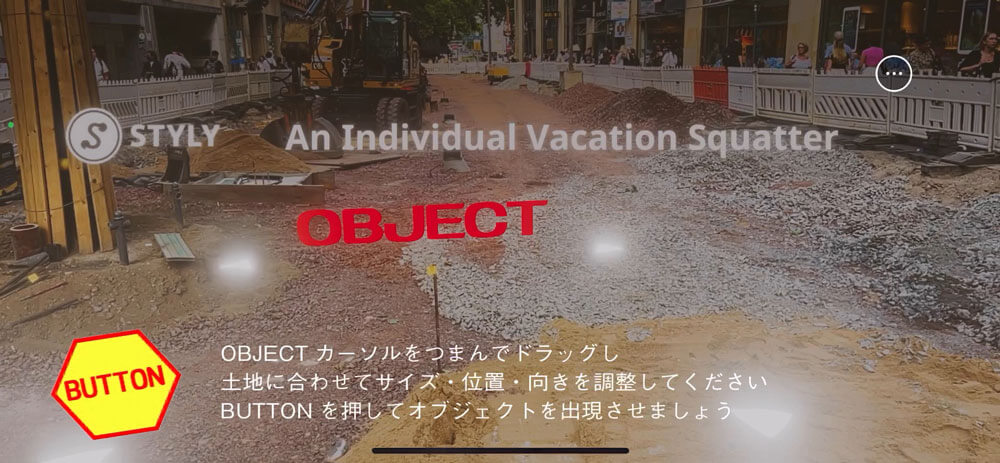
After finding a suitable vacant lot, hold the AR marker over the ground. The word “OBJECT” will appear on the screen. Then, pinch and drag the cursor to adjust the size, position, and orientation according to the size of the land. Once you have determined the size, press “BUTTON” to make the object appear.
First, some signs, billboards, and benches appear. Electric signs, such as “A Clay Wall Pool, 600 Years Later” “Passage Remover,” “Clay Wall,” “Gnawing Iron,” and “Vending Machine Tank,” shine brightly. The poetic combination of words creates a completely different scene in the deserted vacant lot.
The objects that appear depend on the size of the space. In a larger area, vending machine tanks appear. The tanks sway back and forth slowly. Behind the vending machines, the words “Playground Equipment” are displayed in Kanji. Interpreting these words literally, one could use the vending machines as an iron bar to hang upside down—or it could be fun to go underneath them, like a limbo bar.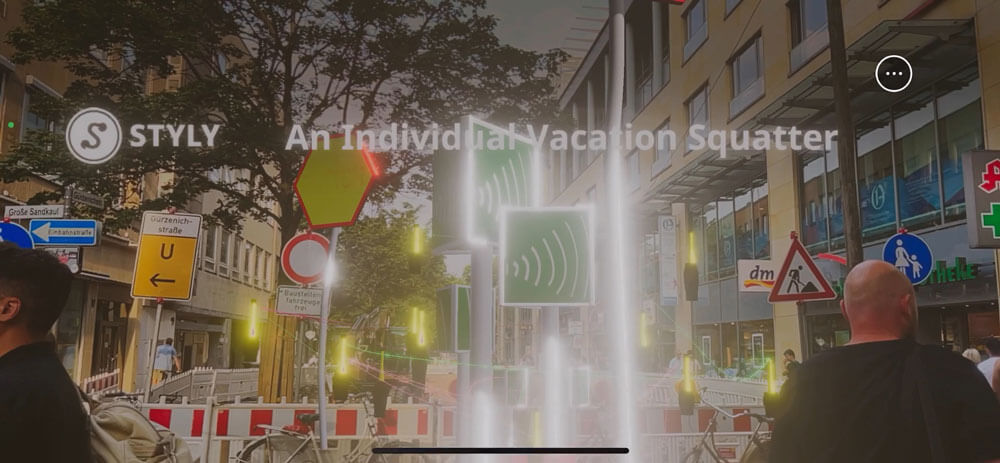
In an even larger space, a variety of signs appear. The signs that exist in reality and those that appear in AR are mixed together. At first glance, it is difficult to tell which signs are real and which ones are three dimensional. However, the AR sign poles move in a strange fashion, so it is quite noticeable that those are the virtual objects.
Objects of other sizes can be viewed in the video below:
About the Artist
Asako Fujikura
Artist | Japan
Asako expresses the site where the foundations of the contemporary city and industrial products have acquired autonomy and objects emerge as objects. These video works and installations focus on the reality that evokes the primitive sensibilities latent in cities. She has exhibited her work both in Japan and abroad.
https://linktr.ee/asakofujikura
(Cited from the NEWVIEW official website)
Who Owns the Virtual Space?
Have you ever heard of the legendary 59 RIVOLI atelier in Paris? It began in the late 1990s when a group of artists illegally took over a long-vacant building in the heart of Paris. Many artists from all over the world still come to this atelier, where they hold exhibitions, parties, performances, and other events on a regular basis in addition to their creative activities.
This phenomenon of art filling gaps—those mysterious spaces that have an owner but are not being used by anyone—has always occurred in cities. There must be something in the alien atmosphere that lurks amid a city’s incessant flow of people that triggers the creativity of artists.
From a different perspective, An Individual Vacation Squatter attempts to occupy the empty spaces buried in the city margins. Instead of the physical approach, Fujikura uses digital technology to approach the virtual space. So, who owns this virtual space that is replicable and infinitely expandable? And how will the virtual space exchange with reality in the future?
We are at a time when the virtual is just beginning to mix with reality. Thus, this may be the only time for a period of moratorium, so to speak, on the virtual space that has yet to be developed. A gentle gap in the virtual space does not resist the intervention of artistic freedom. Perhaps there will be a day in the future when we look back fondly on this era and say, “Oh, how free we were in those virtual days.”
We invite you to experience these objects in An Individual Vacation Squatter, squatting whimsically and stretching their limbs freely in the city’s vacant land.
How to experience an AR scene
If you are accessing this page from a smartphone, please click on the “Experience the Scene” button (*If you are experiencing the scene on a smartphone for the first time, please also refer to the following instructions).
After clicking, the following screen will be displayed.
If you have already downloaded the STYLY Mobile app, please select “Continue on Browser”.
You can then select “Play on Mobile App” to experience the scene.
If you are accessing this page from a PC (web browser), you can experience the scene by clicking the “Experience the Scene” button, selecting the Mobile icon on the scene page, and scanning the QR code.
Download the STYLY Mobile app
For those who want to know more about how to experience the scene
For more information on how to experience AR scenes, please refer to the following article.
Edited by SASAnishiki
Translated by cpnnn

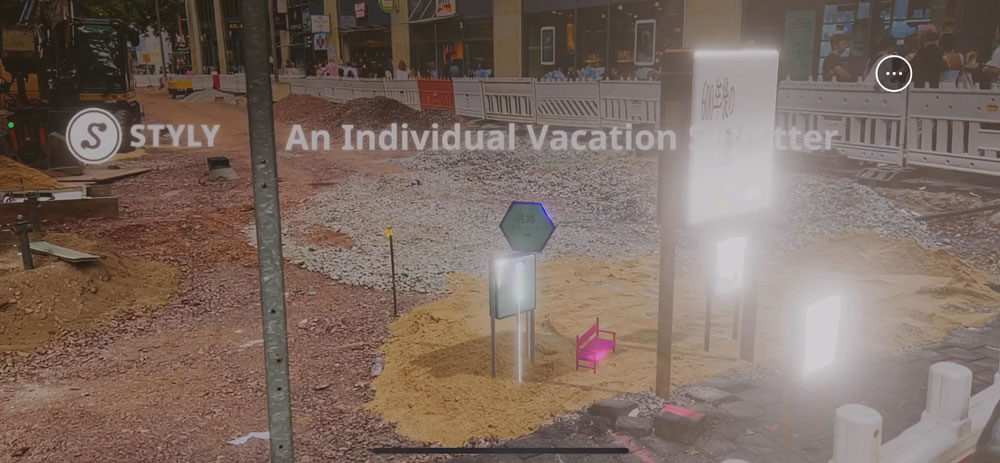
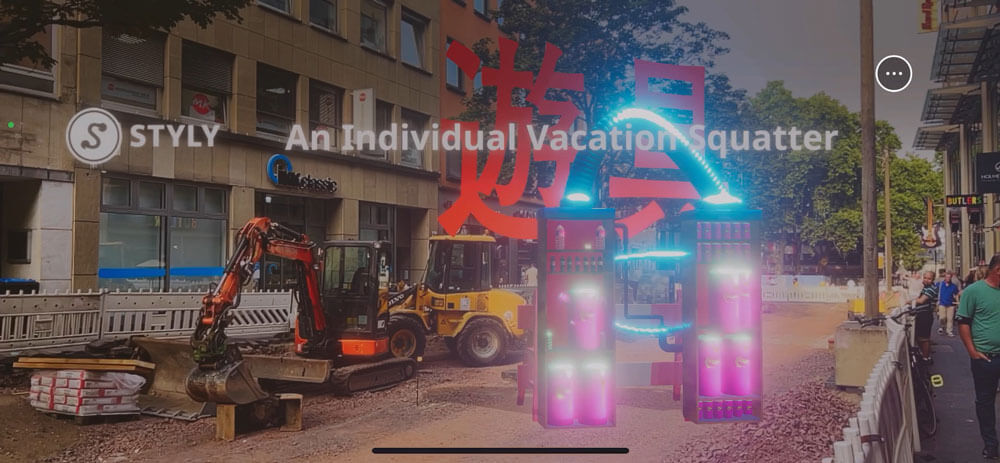
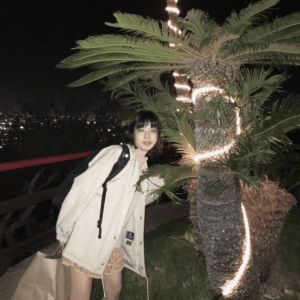

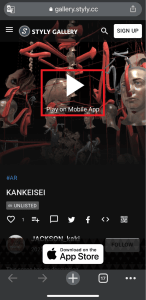
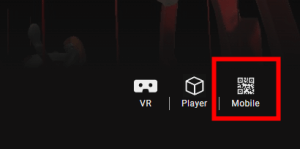


![[Summary] How to experience STYLY scenes VR/AR(Mobile) / Web Browser Introduction by step](https://styly.cc/wp-content/uploads/2020/04/スクリーンショット-2020-04-10-12.53.04-160x160.png)